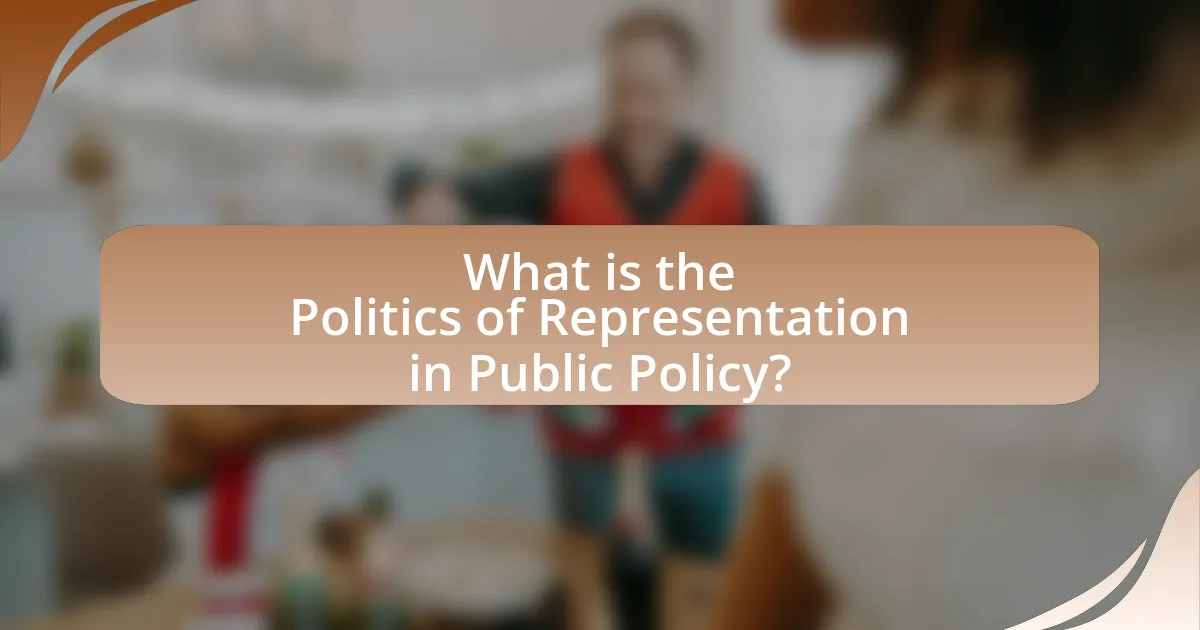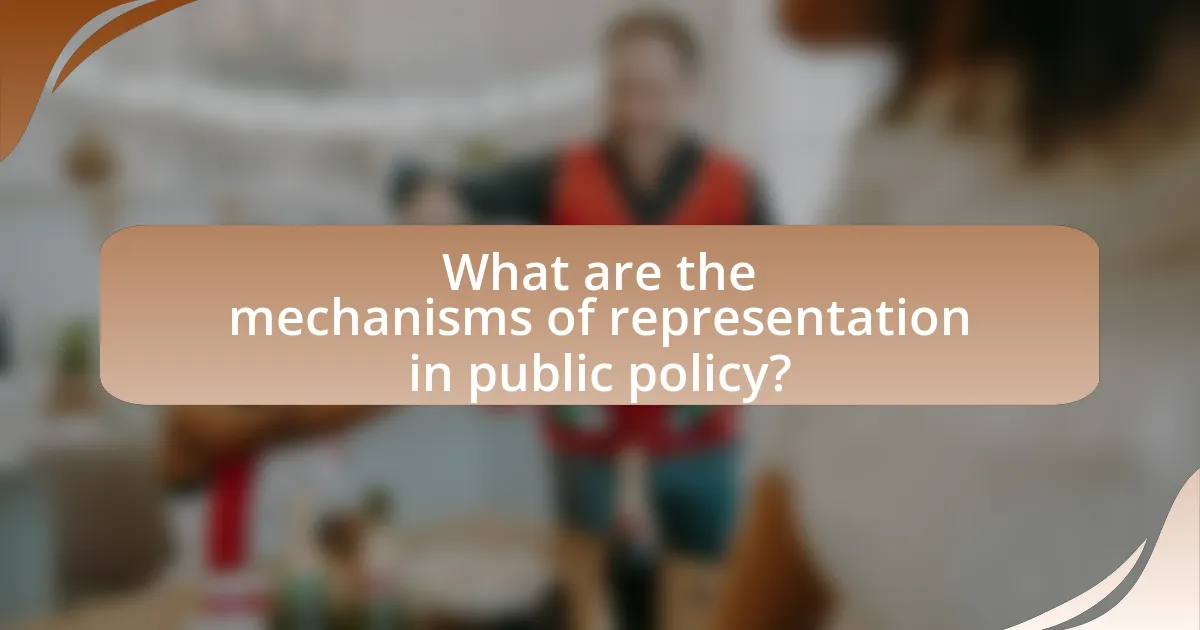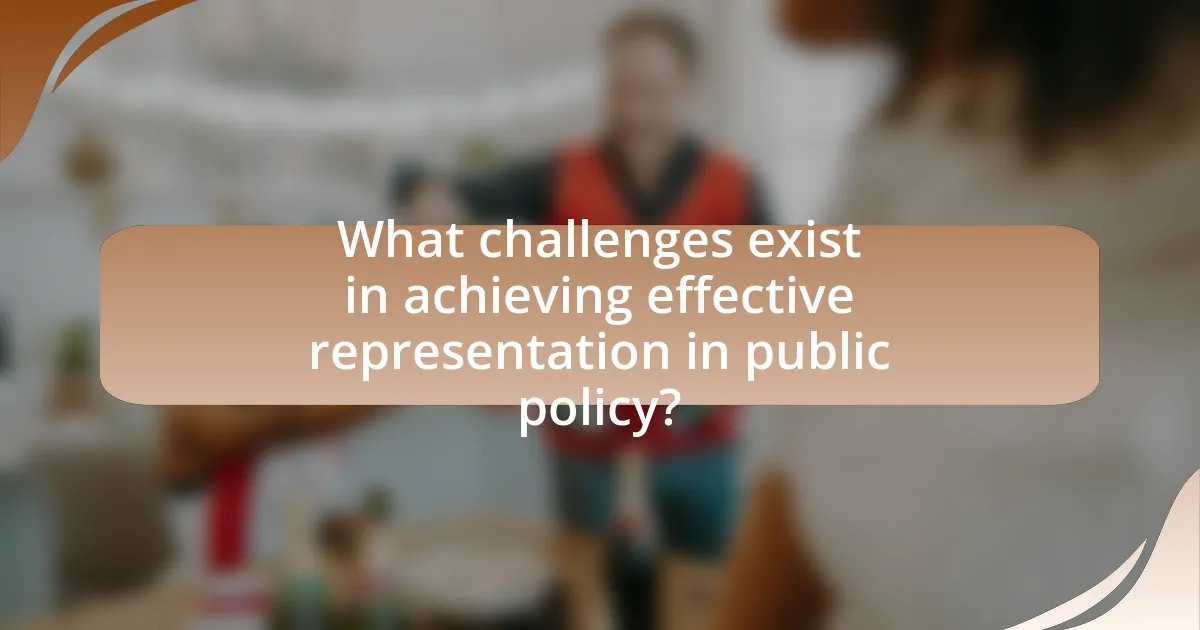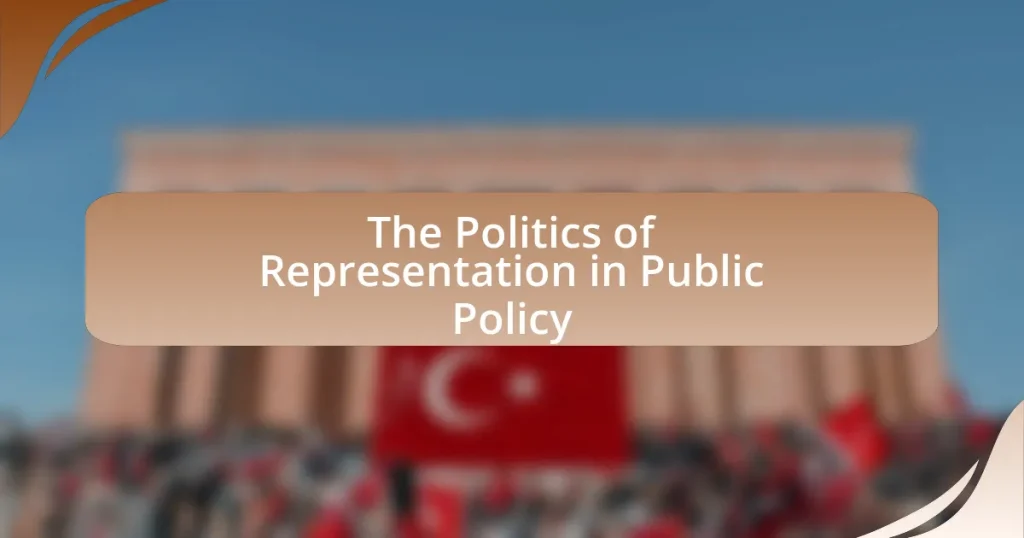The politics of representation in public policy encompasses the processes through which diverse groups and interests are included in policy formulation and implementation. This article examines the significance of representation, particularly for marginalized communities, and its impact on equitable policy outcomes. Key theories of representation, the influence of different political systems, and the role of interest groups and elected officials in shaping public policy are discussed. Additionally, the article addresses challenges to effective representation, including systemic inequalities and voter apathy, while proposing strategies for enhancing inclusivity in governance. Finally, it explores future trends in representation, including the effects of globalization and social media on public policy engagement.

What is the Politics of Representation in Public Policy?
The politics of representation in public policy refers to the processes and dynamics through which various groups and interests are represented in the formulation and implementation of policies. This concept emphasizes the importance of ensuring that diverse voices, particularly those of marginalized communities, are included in decision-making processes. Research indicates that effective representation can lead to more equitable policy outcomes, as seen in studies showing that inclusive policymaking often results in policies that better address the needs of underrepresented populations. For instance, the 2018 report by the National Academy of Sciences highlights that policies developed with input from diverse stakeholders tend to be more effective and sustainable.
How does representation influence public policy decisions?
Representation significantly influences public policy decisions by ensuring that diverse perspectives and interests are considered in the policymaking process. When elected officials or representatives reflect the demographics and values of their constituents, they are more likely to advocate for policies that address the specific needs and concerns of those groups. For instance, research by the American Political Science Review indicates that minority representation in legislative bodies leads to increased attention to issues affecting those communities, such as healthcare and education. This correlation demonstrates that effective representation can lead to more equitable and responsive public policies, ultimately shaping the legislative agenda to better serve the population’s varied interests.
What are the key theories of representation in public policy?
The key theories of representation in public policy include the delegate model, the trustee model, and the politico model. The delegate model posits that representatives act strictly according to the preferences of their constituents, ensuring direct accountability. The trustee model suggests that representatives use their judgment to make decisions that they believe are in the best interest of their constituents, even if those decisions diverge from constituents’ immediate preferences. The politico model combines elements of both, where representatives act as delegates on issues that are important to their constituents and as trustees on more complex or less salient issues. These theories are foundational in understanding how elected officials interpret their roles and responsibilities in the policymaking process.
How do different political systems affect representation?
Different political systems significantly affect representation by determining how citizens’ voices are integrated into governance. In democratic systems, representation is often achieved through elected officials who are accountable to their constituents, ensuring that diverse viewpoints are considered in policy-making. For example, proportional representation systems, like those in Sweden, allow for a wider array of political parties to gain seats in the legislature, reflecting a broader spectrum of public opinion. Conversely, authoritarian regimes typically limit representation by suppressing dissent and controlling political expression, which can lead to policies that do not reflect the will of the populace. Historical evidence shows that countries with democratic frameworks, such as Canada, tend to have higher levels of citizen engagement and satisfaction with governance compared to those with autocratic systems, like North Korea, where representation is virtually non-existent.
Why is representation important in the context of public policy?
Representation is important in the context of public policy because it ensures that diverse voices and interests are included in the decision-making process. When representatives reflect the demographics and experiences of the population, policies are more likely to address the needs and concerns of all citizens. For example, studies show that when women are represented in legislative bodies, issues such as healthcare and education receive more attention, leading to more comprehensive policies. This inclusivity fosters trust in government and enhances the legitimacy of public policies, as citizens feel their perspectives are acknowledged and valued.
What role does representation play in democratic governance?
Representation is fundamental to democratic governance as it ensures that diverse voices and interests within a society are reflected in decision-making processes. This mechanism allows elected officials to act on behalf of their constituents, thereby fostering accountability and responsiveness in government. For instance, studies show that countries with higher levels of representation, such as proportional representation systems, tend to have more equitable policies and greater public trust in government. This correlation underscores the importance of representation in achieving effective governance and promoting social justice.
How does representation impact marginalized communities?
Representation significantly impacts marginalized communities by influencing policy decisions that directly affect their lives. When marginalized groups are represented in political and social spheres, their unique needs and perspectives are more likely to be acknowledged and addressed in public policy. For instance, research by the American Political Science Review indicates that increased representation of women and racial minorities in legislative bodies leads to more equitable policies, such as those related to healthcare, education, and social services. This correlation demonstrates that representation not only empowers these communities but also fosters a more inclusive political environment, ultimately leading to improved outcomes for marginalized populations.

What are the mechanisms of representation in public policy?
The mechanisms of representation in public policy include electoral representation, interest group advocacy, and participatory governance. Electoral representation occurs when elected officials act on behalf of their constituents, ensuring that diverse viewpoints are considered in policy-making. Interest group advocacy involves organizations that represent specific interests, lobbying policymakers to influence legislation and public decisions. Participatory governance allows citizens to engage directly in the policy-making process through public consultations, town hall meetings, and advisory committees, thereby enhancing democratic accountability. These mechanisms collectively ensure that various societal interests are represented in the formulation and implementation of public policies.
How do interest groups shape representation in public policy?
Interest groups shape representation in public policy by advocating for specific interests and influencing policymakers through lobbying, funding, and mobilizing public opinion. These groups often provide expertise, research, and data that inform legislative decisions, thereby ensuring that their perspectives are considered in the policymaking process. For example, the American Medical Association has historically influenced healthcare policy by representing physicians’ interests and providing critical insights on medical issues. Additionally, interest groups can mobilize constituents to contact their representatives, amplifying their voices and increasing the likelihood that their concerns are addressed in public policy. This dynamic illustrates how interest groups play a crucial role in shaping the legislative agenda and ensuring diverse representation in government decisions.
What strategies do interest groups use to influence policy?
Interest groups use various strategies to influence policy, including lobbying, grassroots mobilization, and political contributions. Lobbying involves direct interaction with lawmakers and government officials to advocate for specific legislation or regulations. For instance, the American Medical Association employs lobbyists to promote healthcare policies that benefit its members. Grassroots mobilization encourages members and the public to engage in advocacy efforts, such as organizing protests or campaigns to raise awareness about specific issues. An example is the National Rifle Association, which mobilizes its members to contact legislators regarding gun rights. Political contributions through Political Action Committees (PACs) also play a crucial role, as interest groups can financially support candidates who align with their policy goals, thereby increasing their influence in the political arena.
How effective are interest groups in achieving representation?
Interest groups are highly effective in achieving representation by influencing public policy and decision-making processes. They mobilize resources, engage in lobbying, and utilize grassroots campaigns to advocate for specific interests, which can lead to significant legislative outcomes. For instance, the American Association of Retired Persons (AARP) successfully lobbied for the Medicare Prescription Drug, Improvement, and Modernization Act of 2003, demonstrating the power of organized interest groups in shaping policy that affects millions. Additionally, research indicates that interest groups with substantial financial backing and membership can exert considerable influence over lawmakers, as seen in the National Rifle Association’s (NRA) impact on gun legislation. This effectiveness is further supported by studies showing that interest groups often provide lawmakers with critical information and expertise, thereby enhancing their ability to represent specific constituencies.
What role do elected officials play in representation?
Elected officials serve as representatives of their constituents, translating the interests and needs of the public into policy decisions. They engage in legislative processes, advocate for community concerns, and ensure that diverse voices are heard in government. For instance, in the United States, members of Congress are tasked with representing the views of their districts, which is evident in their voting patterns and public statements that reflect constituent feedback. This role is crucial for a functioning democracy, as it fosters accountability and responsiveness in governance.
How do elected officials balance constituent interests with party agendas?
Elected officials balance constituent interests with party agendas by prioritizing local needs while adhering to party principles. They engage in regular communication with constituents through town halls, surveys, and social media to gauge public opinion and understand specific concerns. For instance, a study by the Pew Research Center found that 70% of voters expect their representatives to consider their views when making decisions. Simultaneously, officials must align their actions with party platforms to maintain party support and secure funding for initiatives. This dual responsibility often leads to negotiations and compromises, where officials advocate for constituent needs within the framework of party policies, ensuring both local and party interests are addressed.
What factors influence the responsiveness of elected officials?
Elected officials’ responsiveness is influenced by several key factors, including public opinion, electoral incentives, and institutional constraints. Public opinion shapes officials’ actions as they seek to align with the preferences of their constituents to secure votes. For instance, studies show that elected representatives are more likely to respond to issues that are salient to their voters, as indicated by surveys and polls. Electoral incentives drive officials to prioritize the needs and concerns of their electorate, particularly in competitive districts where re-election is at stake. Additionally, institutional constraints, such as legislative rules and party dynamics, can limit or enhance the ability of elected officials to act on constituents’ demands. Research indicates that these factors collectively determine how effectively elected officials respond to the public, as evidenced by various case studies in political science literature.

What challenges exist in achieving effective representation in public policy?
Achieving effective representation in public policy faces several challenges, including systemic inequalities, lack of access to decision-making processes, and the influence of special interest groups. Systemic inequalities, such as socioeconomic disparities, often result in marginalized communities being underrepresented in policy discussions. For instance, a report by the U.S. Census Bureau indicates that lower-income individuals are less likely to participate in civic activities, which diminishes their influence on public policy. Additionally, the complexity of legislative processes can create barriers for ordinary citizens, making it difficult for them to engage meaningfully. Special interest groups, often funded by significant financial resources, can overshadow the voices of average constituents, leading to policies that favor the interests of a few over the many. This dynamic is supported by research from the Center for Responsive Politics, which shows that lobbying expenditures in the U.S. reached over $3.5 billion in 2020, highlighting the disproportionate power held by these entities in shaping public policy.
What barriers hinder equitable representation in public policy?
Barriers that hinder equitable representation in public policy include systemic inequalities, lack of access to decision-making processes, and socio-economic disparities. Systemic inequalities manifest in various forms, such as racial, gender, and class biases, which limit the participation of marginalized groups in policy discussions. Additionally, the lack of access to decision-making processes often results from institutional structures that favor established interests over diverse voices. Socio-economic disparities further exacerbate these issues, as individuals from lower-income backgrounds may lack the resources or networks necessary to engage effectively in public policy. Research indicates that these barriers contribute to a significant underrepresentation of certain demographics in policy-making, ultimately affecting the fairness and inclusivity of public policies.
How do socioeconomic factors affect representation?
Socioeconomic factors significantly affect representation by influencing who has access to political power and decision-making processes. Individuals from higher socioeconomic backgrounds often have greater resources, education, and social networks, which enable them to engage more effectively in politics and advocacy. For instance, research shows that wealthier individuals are more likely to contribute to political campaigns and have their voices heard in policy discussions, leading to a disproportionate influence on public policy outcomes. Additionally, socioeconomic disparities can result in underrepresentation of marginalized groups, as those with lower income and education levels may lack the means to participate fully in the political system, thereby skewing representation in favor of the affluent.
What impact does voter apathy have on representation?
Voter apathy significantly undermines representation by leading to lower voter turnout, which skews electoral outcomes and diminishes the legitimacy of elected officials. When a substantial portion of the electorate abstains from voting, the resulting representation may not accurately reflect the preferences and needs of the entire population. For instance, in the 2016 U.S. presidential election, approximately 43% of eligible voters did not participate, which allowed candidates to be elected with support from a minority of the electorate. This disparity can result in policies that favor the interests of active voters while neglecting the concerns of those who are disengaged, ultimately perpetuating a cycle of disenfranchisement and further apathy.
How can representation in public policy be improved?
Representation in public policy can be improved by increasing the diversity of decision-makers and ensuring inclusive participation in the policy-making process. Research indicates that diverse groups bring varied perspectives, which can lead to more comprehensive and equitable policies. For instance, a study by the National Academy of Sciences found that diverse teams are more innovative and effective in problem-solving, which is crucial for addressing complex societal issues. Additionally, implementing mechanisms such as public consultations, participatory budgeting, and community advisory boards can enhance citizen engagement and ensure that marginalized voices are heard in policy discussions.
What best practices can enhance representation for underrepresented groups?
Best practices that can enhance representation for underrepresented groups include implementing inclusive policies, fostering diverse leadership, and ensuring equitable access to resources. Inclusive policies, such as affirmative action and targeted outreach programs, actively promote participation from marginalized communities. Diverse leadership within organizations and government bodies ensures that decision-making reflects a variety of perspectives, which can lead to more equitable outcomes. Additionally, providing equitable access to resources, such as education and funding, empowers underrepresented groups to engage fully in public policy processes. Research indicates that organizations with diverse leadership are more innovative and better at problem-solving, which underscores the importance of these practices in enhancing representation.
How can technology facilitate better representation in public policy?
Technology can facilitate better representation in public policy by enabling more inclusive participation and enhancing data-driven decision-making. Digital platforms allow diverse groups to engage in policy discussions, ensuring that marginalized voices are heard. For instance, tools like online surveys and social media campaigns can gather public opinions from a wider demographic, leading to policies that reflect the needs of the community. Additionally, data analytics can identify trends and issues affecting specific populations, allowing policymakers to tailor solutions effectively. Research shows that jurisdictions employing technology for public engagement report higher satisfaction rates among constituents, indicating that technology plays a crucial role in fostering representative governance.
What are the future trends in the politics of representation?
Future trends in the politics of representation include increased diversity in political representation, driven by demographic shifts and social movements advocating for marginalized groups. As populations become more diverse, there is a growing demand for representatives who reflect this diversity, leading to policies that prioritize inclusion and equity. For instance, the 2020 U.S. Census revealed significant increases in racial and ethnic minorities, prompting political parties to adapt their strategies to attract these voters. Additionally, the rise of digital platforms facilitates grassroots movements, enabling underrepresented voices to gain visibility and influence in policy discussions. This trend is supported by data showing that diverse leadership correlates with more comprehensive and effective policymaking, as seen in various studies highlighting the benefits of inclusive governance.
How is globalization affecting representation in public policy?
Globalization is affecting representation in public policy by increasing the influence of transnational actors and reducing the power of local governments. As global economic and political interdependencies grow, multinational corporations and international organizations often shape policy agendas, leading to a shift in focus from local needs to global standards. For instance, the World Trade Organization’s regulations can dictate national policies, prioritizing trade liberalization over local economic interests. This dynamic can marginalize local voices and diminish democratic accountability, as decisions may be made in forums that lack direct public engagement.
What role will social media play in shaping future representation?
Social media will play a crucial role in shaping future representation by providing a platform for diverse voices and facilitating direct engagement between citizens and policymakers. This democratization of communication allows underrepresented groups to share their perspectives and mobilize support for their causes, thereby influencing public policy decisions. For instance, movements like #BlackLivesMatter and #MeToo have utilized social media to raise awareness and drive legislative change, demonstrating its power in amplifying marginalized voices. As a result, social media not only enhances visibility for various issues but also pressures policymakers to respond to the demands of a more informed and engaged electorate.
What practical steps can individuals take to engage in the politics of representation?
Individuals can engage in the politics of representation by actively participating in local governance, advocating for inclusive policies, and supporting diverse candidates. Engaging in local governance can involve attending town hall meetings, where individuals can voice their concerns and influence decision-making processes. Advocating for inclusive policies means promoting initiatives that address the needs of underrepresented communities, such as equitable access to resources and services. Supporting diverse candidates can be achieved by volunteering for campaigns, donating to political organizations that prioritize representation, and voting in elections to ensure that a variety of perspectives are included in public policy discussions. These actions contribute to a more representative political landscape, as evidenced by studies showing that increased civic engagement leads to policies that better reflect the demographics and needs of the community.










